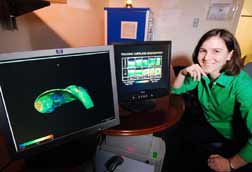 |
| Georgia Tech student Ashley Palmer, Ph.D., conducted experiments to validate a new cartilage-imaging technique developed by associate professors Marc Levenston and Robert Guldberg in the Georgia Tech School of Mechanical Engineering. On the computer screen in the foreground is a thickness “map” of cartilage on a rabbit thigh bone generated using software associated with the new imaging technique called EPIC-microCT. On the other screen is an image showing results of EPIC-microCT scans on bovine cartilage samples at various stages of degradation. |
…
Add new comment